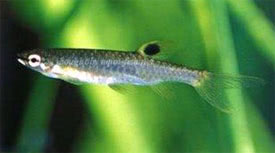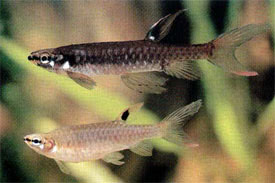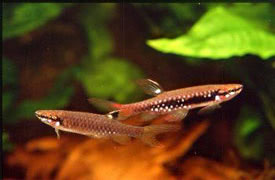
 Magyarul / Hungarian
Magyarul / Hungarian



- Scientific name: Copella arnoldi
- Common name: Splash tetra, Jumping characin
- Group: Characins
- Habitat: South America; Guyana
- Size: 6 cm
- Biotope: Near the banks of slow-moving rivers with heavy vegetation.
- Social behavior: A peaceful fish that can be kept in pairs or schools. Does well in a community tank.
- Diet: Live, small flying insects, insect larvae, brine shrimp, flakes.
- Breeding: Quite easy
- Tank: Minimum 60 litres
- Population: 1 pair for 70 litres
- Decoration: The tank should be well-planted andhave a cover of floating plants. Position the tank in a place where it will receive morning sunlight. Use a tight-fitting cover as this fishis a jumper.
- Temperature: 24-26°C
- pH: 6,5-7
- Hardness: 2,6-8,4NK°
- Lifespan: 3 years
Description: The Splash Tetra has an elongated body. The body color is olive green to brownand the belly is white. A stripe, slightly darker than the body color, extends from the gill cover to the caudalfin. Athin copper-colored line runs right above the darker band. A black band extends from the snout, throughthe eye, and to the gill cover. In favorable water conditions, the upper half of the iris will develop an iridescent orangecolor.
The males are more colorful, larger, and have more elaborate fins.
This species is popular because of its peculiar spawning habits. This fish can be bred in small tanks(16" or 5 gallons). The water should be soft and slightly acidic, with the water level several inches lowerthan normal (4-8"). The pair should be fed live foods, such as those suggested in the introduction of thisgenus. The pair will jump against an overhanging leaf or the tank glass, and press their bodies together. About8-10 eggs are laid on the object. This process is repeated until 150-200 eggs are laid. The male engage in brood care by splashingwater on the eggs every 10-15 minutes. After 30-40 hours the eggs hatch and the fry drop into the water. Theparents should be removed at this time. The fry are very small and should be fed small live foods. Thisspawning habit most likely developed from a large amount of predators that can be found in this fish's naturalhabitat. The eggs are sometimes laid on the underside of the tank lid.


















